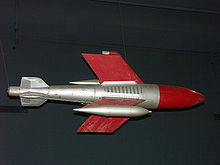Ruhrstahl X-4
| Ruhrstahl X-4 | |
|---|---|
| General Information | |
| Type | Air-to-air missile |
| Local name | Ruhrstahl X-4 |
| Country of origin | German Empire |
| Manufacturer | Ruhrstahl AG |
| development | Max Kramer |
| Commissioning | never |
| Technical specifications | |
| length | 2010 mm |
| diameter | 220 mm |
| Combat weight | 60 kg |
| span | 726 mm |
| drive | Liquid rocket engine BMW 109-548; Solid rocket engine Schmidding 109-603 (optional) |
| speed | 900 km / h |
| Range | 3500 to 5500 m |
| Furnishing | |
| steering | FuG 510/238 "Düsseldorf / Detmold" (wire steering) |
| Target location | manually |
| Warhead | 20 kg |
| Detonator | Acoustic distance detonator from Kranich |
| Weapon platforms | multi-seat combat aircraft |
| Lists on the subject | |
The Ruhrstahl X-4 (also Kramer X4 or RK 344 Ruhrstahl-Kramer ) was a German wire- guided air-to-air missile (known today as MCLOS ) that was developed by Max Kramer , an engineer from Ruhrstahl AG , during World War II . Development began in early 1943, and 1,300 units had been produced by the end of the war.
history
A few years before development began, Kramer had already been working on techniques with which bombs should be made controllable during the flight phase. The idea was to direct missiles into enemy formations beyond the reach of allied defensive weapons . This consideration 4 X went forth, with the BMW - rocket motor of the type equipped 109-548, of the mainly of aluminum and plywood could make existing missile to a speed of around 900 km / h. The rocket was propelled by a hypergolic mixture of S-material (95 percent nitric acid ) and R-material ( Tonka -250; a mixture of triethylamine and xylidine ), which brought a thrust of 140 kp. Due to difficulties in storing the nitric acid as well as control and stabilization problems during the flight, the use of a powder rocket drive was initially planned. This engine, developed by Wilhelm Schmidding in Bodenbach under the designation 109-603, consisted of a cast diglycol powder charge and developed a thrust of 150 kilopond for eight seconds, i.e. a total impulse of 1200 kps.
The control impulses for steering the X-4 were transmitted through two wires wound on spools ( wire remote steering ). This procedure was intended to direct the missile into enemy aircraft formations . The engine noise of the targeted aircraft should activate the acoustic sensors, which then detonated the missile.
The first test flight took place on August 11, 1944 with a Focke-Wulf Fw 190 . The original plan was to equip single-seat aircraft with the X-4. However, it turned out that it was extremely difficult for the pilots to direct their own aircraft and, in addition, the missile. In this test phase, two thin wires transmitted the control pulses. The two control wire coils were housed in two gondolas at the tip of two opposite wings. To stabilize the flight path, the X4 rotated at one revolution per second around its own longitudinal axis. An automatic compensation device converted the steering commands into rudder deflections, whereby the natural rotation was taken into account. The pilot steered the missile on target by bringing it into line with the targeted object. For this purpose, flares were attached to the other two wing tips. Due to the problems mentioned, the X-4 should be used in multi-seat aircraft such as the Ju 88 .
Ruhrstahl had built 1300 X-4s by 1945. The end of the war and the destruction of the BMW production facility for rocket motors prevented further production, so the rocket was never used.
A similar development was the Ruhrstahl X-7 anti-tank guided missile developed from 1944 .
See also
literature
- Roger Ford: The German Secret Weapons of World War II. Nebel, ISBN 3-89555-087-6 .
- Josef Stemmer: rocket drives. Swiss printing and publishing house, Zurich 1952.
- Jean-Denis Lepage: Aircraft of the Luftwaffe, 1935–1945. McFarland & Company, 2009.
Web links
Individual evidence
- ↑ 109-548 (P3378). In: BMW history. BMW AG, accessed on January 25, 2018 (dossier of the BMW Group Archives).


